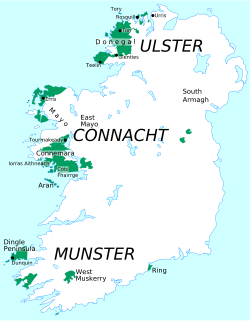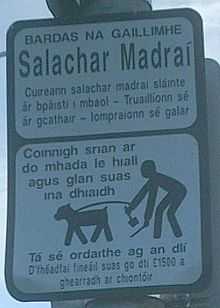Connacht Irish


Connacht Irish is the dialect of the Irish language spoken in the province of Connacht. Gaeltacht regions in Connacht are found in Counties Mayo (notably Tourmakeady, Achill Island and Erris) and Galway (notably in parts of Connemara and on the Aran Islands). The Mayo and Galway varieties differ from each other in a variety of ways, as Mayo is geographically between Galway and Donegal, making Mayo Irish have a number of features in common with Donegal that Galway does not have.
Lexicon
Some differences between Mayo and Galway are seen in the lexicon:
| Mayo | Galway | Gloss |
|---|---|---|
| cluinim | cloisim | "I hear" |
| doiligh | deacair | "difficult" |
| úr | nua | "new" |
| nimhneach | tinn | "sore" |
Some words used in Connacht Irish that aren't found in other dialects include:[1]
- cas, verbal noun casadh to mean "meet", (standard buail, bualadh)
- gasúr, meaning a young child (the form is used in Munster Irish, but to refer to a young boy).
- cisteanach, "kitchen" (Munster form cistin)
Variant spellings include:
- tíocht, verbal noun of tar, "to come" (standard teacht)
- aríst, "again" (standard arís)
- caiptín, "captain" (standard captaen)
- col ceathrar, "cousin" (standard col ceathrair)
- feilm, feilméar, "farm", "farmer" (standard feirm, feirmeoir)
Variants distinctive of, but not unique to Connacht include:
- fata,fataí, "potato", "potatoes"
- fuisce, "whiskey"
- muid, emphatic form muide for the first person plural pronoun, Ulster Irish uses this form as well, whereas Munster Irish uses sinn, sinne.
Phonology
The phonemic inventory of Connacht Irish (based on the accent of Tourmakeady in Mayo[2]) is as shown in the following chart (see International Phonetic Alphabet for an explanation of the symbols). Symbols appearing in the upper half of each row are velarized (traditionally called "broad" consonants) while those in the bottom half are palatalized ("slender"). The consonant /h/ is neither broad or slender.
| Consonant phonemes |
Labial | Coronal | Dorsal | Glottal | ||||||||||||||
|---|---|---|---|---|---|---|---|---|---|---|---|---|---|---|---|---|---|---|
| Bilabial | Labio- dental |
Labio- velar |
Dental | Alveolar | Alveolo- palatal |
Palatal | Velar | |||||||||||
| Plosive | pˠ pʲ | bˠ bʲ |
t̪ˠ | d̪ˠ |
tʲ | dʲ |
c | ɟ |
k | ɡ |
||||||||
| Fricative/ Approximant |
fˠ fʲ | vʲ |
w |
sˠ | ʃ | ç | j |
x | ɣ |
h | ||||||||
| Nasal | mˠ mʲ |
n̪ˠ n̪ʲ |
nˠ nʲ |
ɲ |
ŋ |
|||||||||||||
| Tap | ɾˠ ɾʲ |
|||||||||||||||||
| Lateral approximant |
l̪ˠ l̪ʲ |
lˠ lʲ |
||||||||||||||||
The vowels of Connacht Irish are as shown on the following chart. These positions are only approximate, as vowels are strongly influenced by the palatalization and velarization of surrounding consonants.

In addition, Connacht has the diphthongs /iə, uə, əi, əu/.
Some characteristics of Connacht that distinguish it from the other dialects are:
- In some varieties, vowel lengthening before word-internal clusters of voiced plosive + liquid (e.g. /ɑːɡləʃ/ eaglais "church"
- In some varieties, a four-way distinction among coronal nasals and laterals: /n̪ˠ ~ n̪ʲ ~ nˠ ~ nʲ/, /l̪ˠ ~ l̪ʲ ~ lˠ ~ lʲ/, often without lengthening of orthographic short vowels before them.
- In the variety spoken in Cois Fharraige (the area along the north shore of Galway Bay between Barna and Casla), underlying short /a/ is realized as a long front [aː] while underlying long /aː/ is realized as a back [ɑː].
- /n/ is realized as [r] (or is replaced by /r/) after consonants other than [s]. This happens in Ulster as well.
- Broad bh is rendered /w/ even in initial positions, with a few exceptions.
- The inflected pronouns agam, agat, againn, agaibh are usually reduced into monosyllables /am/, /ad/, /an/, /aɡiː/
- The prepositions do, de are frequently pronounced (and sometimes written) in their lenited forms.
- The preposition and article sa causes eclipsis, where it causes lenition in the Caighdeán.
Morphology
Nouns
In some dialects of Connacht the plural endings -anna and -acha are always replaced by -annaí and -achaí. It is also common in many Gaelic-speaking areas of Connemara that the dative singular form of all 2nd declension nouns has been generally adopted as the nominative, giving these nouns the typical ending in palatalized consonants in the nominative singular. This is indicated in the spelling by the letter i before the final consonant.
| Connemara form | Standard form | Gloss |
|---|---|---|
| -achaí, -annaí | -acha, -anna | Plural ending |
| bróig | bróg | "shoe" |
| ceird | ceard | "craft" |
| cluais | cluas | "ear" |
| cois | cos | "foot, leg" |
| láimh | lámh | "hand" |
Verbs
Irish verbs are characterized by having a mixture of analytic/an fhoirm scartha forms (where information about person and number is provided by a pronoun) and synthetic/an fhoirm tháite forms (where this information is provided in an ending on the verb) in their conjugation. In Galway and Mayo, as in Ulster, the analytic forms are used in a variety of forms where the standard language has synthetic forms, e.g. molann muid "we praise" (standard molaimid) or mholfadh siad "they would praise" (standard mholfaidís). However, the synthetic forms, including those no longer included in the standard language, may be used in answering questions.
Díonaim (I make/I do) in standard Irish (Déanaim)
Íosaim (I eat) in standard Irish (Ithim)
Connacht Irish favours the interrogative pronoun cén and forms based on it such as cén t-am, "what time" instead of the standard cathain, or céard instead of the standard cad. Relative forms of the verb such as beas for beidh, "will be", or déananns/déanas, "do", for déanann are frequently used.
References
| German Wikisource has original text related to this article: |
- ↑ Ihde, Thomas; Ní Neachtain, Máire; Blyn-LaDrew, Roslyn; Gillen, John (2008). Colloquial Irish. New York and London: Routledge.
- ↑ de Búrca, Seán (1958). The Irish of Tourmakeady, Co. Mayo. Dublin: Dublin Institute for Advanced Studies. ISBN 0-901282-49-9.
| ||||||||||||||||||||||||||